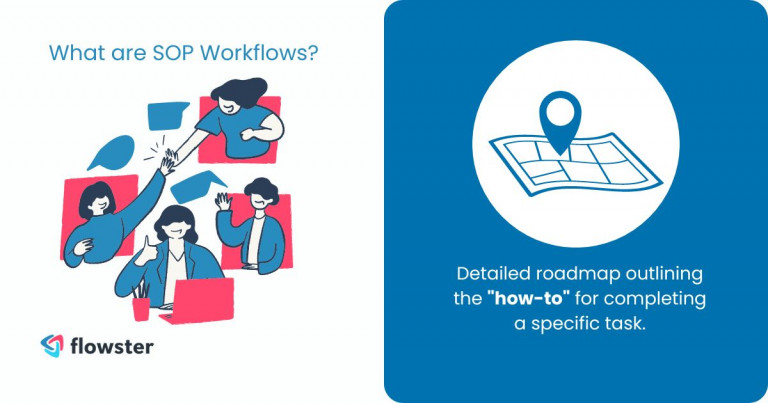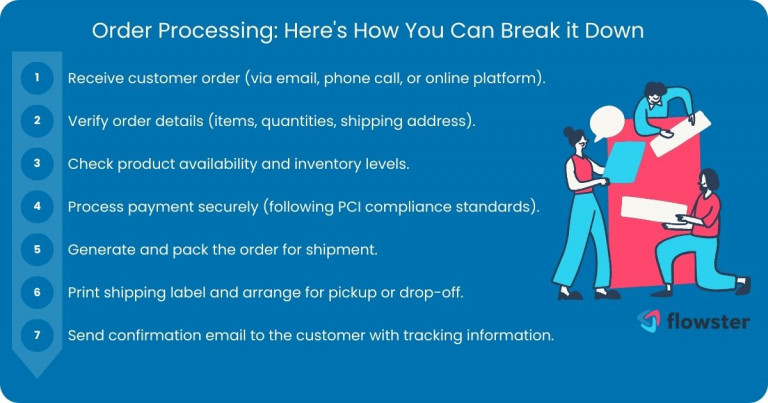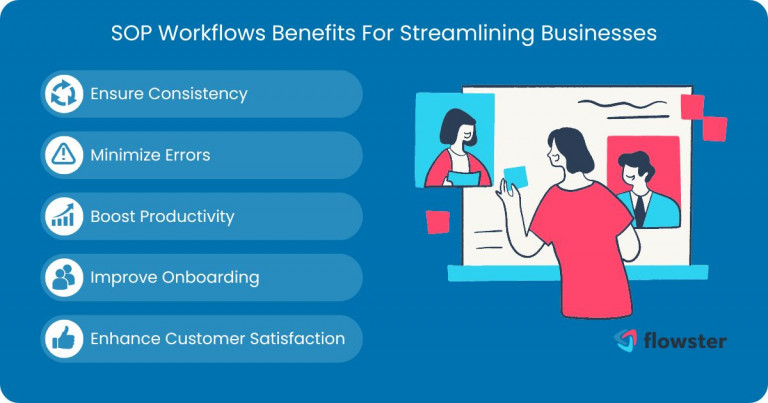Imagine this: A new employee starts their first day, eager to impress. But instead of clear instructions, they’re bombarded with conflicting advice from colleagues. Tasks take longer than expected, mistakes happen, and frustration builds. This is the unfortunate reality of businesses without standardized processes.
The good news? There’s a hero waiting in the wings: SOP workflows. SOP, short for Standard Operating Procedure, is a detailed roadmap outlining the “how-to” for completing a specific task. When combined with workflow management, these SOPs become powerful tools for streamlining your business.
Article Outline
What are SOP Workflows?
SOP workflows are essentially visual representations of these procedures, breaking down complex processes into a step-by-step sequence. This clarity is key to achieving several crucial goals:
- Consistency: Everyone on your team follows the same path, ensuring tasks are completed uniformly and meeting quality standards.
- Reduced Errors: Clear instructions minimize confusion and mistakes, leading to higher efficiency and fewer headaches.
- Saved Time: By eliminating the need to “reinvent the wheel” every time, SOP workflows empower employees to complete tasks quickly and efficiently.
Think about onboarding a new team member; a well-defined SOP workflow can eliminate the guesswork, ensuring a smooth transition for everyone. The same applies to handling customer service inquiries, creating engaging social media content, or any other repetitive task within your business.
By implementing SOP workflows, you’re not just creating order out of chaos; you’re laying the foundation for process improvement. Next, we’ll delve into the exciting world of building your own SOP workflow. From identifying key tasks to choosing the perfect tools, we’ll equip you with the knowledge needed to conquer the business chaos monster and achieve optimal efficiency.

How to Build SOP Workflows: From Chaos to Clarity
Now that you understand the power of SOP workflows for streamlining your business, let’s dive into the actual process of building them. The first step is to identify those tasks that stand to benefit most from a standardized approach.
Step 1: Identify Tasks & Processes
Think about your daily operations. Are there any repetitive tasks that seem to take longer than necessary? Perhaps customer service inquiries are handled inconsistently, leading to confusion and frustration. Maybe onboarding new employees is a haphazard affair, leaving them feeling overwhelmed. These are prime candidates for the SOP workflow treatment.
Here’s a helpful brainstorm prompt to get you started: “What tasks within our business take longer than they should?” Once you have a list of potential areas for improvement, it’s time to break those tasks down into manageable steps.
Step 2: Break Down the Steps
The key to creating effective SOP workflows lies in meticulous process documentation. Take a common business task, like processing an order. This seemingly simple process can involve multiple steps, from receiving the order to verifying payment and shipping the product. Break each of these steps down into clear, concise instructions. For example, “Upon receiving an order, verify customer information and ensure all required fields are complete.”

Step 3: Choose Your Tools
There’s no one-size-fits-all approach when it comes to building SOP workflows. The best tool for you depends on the complexity of your processes and your team’s preferences. Popular options include:
- Project Management Software: These platforms offer robust features for creating workflows, assigning tasks, and tracking progress.
- Flowcharts: Visually map out the steps involved in a process, making it easy for everyone to understand.
- Online Document Editors: Simple and readily available, these tools allow you to create and share SOP documents with your team.
The most important considerations when choosing your tools are accessibility and ease of use. Your SOP workflows should be readily available to your team members, and they shouldn’t require any special technical skills to understand or follow.
Step 4: Document Everything
Once you’ve identified your tasks and chosen your tools, it’s time to meticulously document your SOP workflows. Clarity is key.
Here are some best practices to follow:
- Write clear and concise instructions. Avoid jargon and technical language that your team might not understand.
- Use bullet points and numbered lists to break down complex steps into manageable chunks.
- Incorporate visuals whenever possible. Screenshots, flowcharts, and checklists can significantly enhance understanding.
Remember, your SOP workflows are living documents. Don’t be afraid to revise and update them as needed. Now that you’ve built your SOP workflows, the next step is ensuring they’re implemented effectively and maintained over time.
Flowster's AI-Driven Automation
Implementing & Maintaining SOP Workflows: Keeping Your Systems Running Smoothly
Developing stellar SOP workflows is just the first step. To truly unlock their potential, you need a solid plan for implementation and ongoing maintenance. Here’s how to ensure your SOP workflows become a seamless part of your daily operations.
1. Training & Onboarding:
The success of your SOP workflows hinges on effective team training. There are several ways to approach this:
- Video Tutorials: Create short, engaging videos that walk your team through each step of the SOP workflow.
- Interactive Walkthroughs: Offer hands-on sessions where employees can practice using the SOP workflows with guidance.
- Readily Available Documentation: Ensure that your SOP workflows are easily accessible to all team members, either online or in printed format.
By providing clear and accessible training materials, you empower your team to confidently apply the SOP workflows to their daily tasks.
2. Testing & Revision:
No SOP workflow is perfect. Once implemented, it’s crucial to test its effectiveness and actively seek feedback from your team.
- Encourage open communication: Ask your team members to share their experiences using the SOP workflows. Are there any steps that are unclear? Is anything missing?
- Be receptive to feedback: Don’t be afraid to revise your SOP workflows based on your team’s input.
- Maintain a living document: Remember, SOP workflows are not static documents. Incorporate a revision process to keep them updated as your business evolves and processes improve.
3. Long-Term Sustainability:
Maintaining the effectiveness of your SOP workflows over time requires a long-term commitment. Here are some key strategies:
- Assign Ownership: Designate a team member or department responsible for overseeing the SOP workflows and ensuring their continued relevance.
- Encourage Feedback: Create a culture where employees feel comfortable suggesting improvements to the SOP workflows.
- Adapt to Changing Needs: As your business grows and processes evolve, be prepared to adapt your SOP workflows accordingly.
By following these steps, you can ensure that your SOP workflows remain valuable tools for process improvement and long-term success. In the next section, we’ll wrap up by highlighting the key takeaways and empowering you to take action.

Conclusion: Unleash the Power of Efficiency with SOP Workflows
Throughout this blog post, we’ve explored the transformative power of SOP workflows. We’ve seen how these detailed roadmaps can streamline your business processes, reduce errors, and empower your team to achieve optimal efficiency. By implementing SOP workflows, you can:
- Ensure Consistency: Guarantee that tasks are completed uniformly across your team, leading to higher quality standards.
- Minimize Errors: Clear and concise instructions minimize confusion and mistakes, saving you time and resources.
- Boost Productivity: By eliminating the need to “reinvent the wheel” with every task, your team can work smarter, not harder.
- Improve Onboarding: Streamline the onboarding process for new hires, ensuring a smooth transition and maximizing their potential.
- Enhance Customer Satisfaction: Consistent, high-quality service delivery contributes to happier and more loyal customers.
Ready to experience the benefits of SOP implementation firsthand? Don’t wait any longer! Here at Flowster, we’re passionate about helping businesses achieve peak efficiency.
Take Action: Take the first step towards a more streamlined and successful business by creating your own SOP workflows today. Visit the Flowster Marketplace to download a variety of free SOP workflow examples tailored to different industries and business needs.
Flowster also offers comprehensive “Done-for-You” SOP workflow development services. Our team of experts can handle the entire process, from identifying key tasks to crafting clear and concise documentation.
Let Flowster be your partner in unlocking the power of SOP workflows. Visit our website today to learn more and get started on your journey to a more efficient and profitable business!




